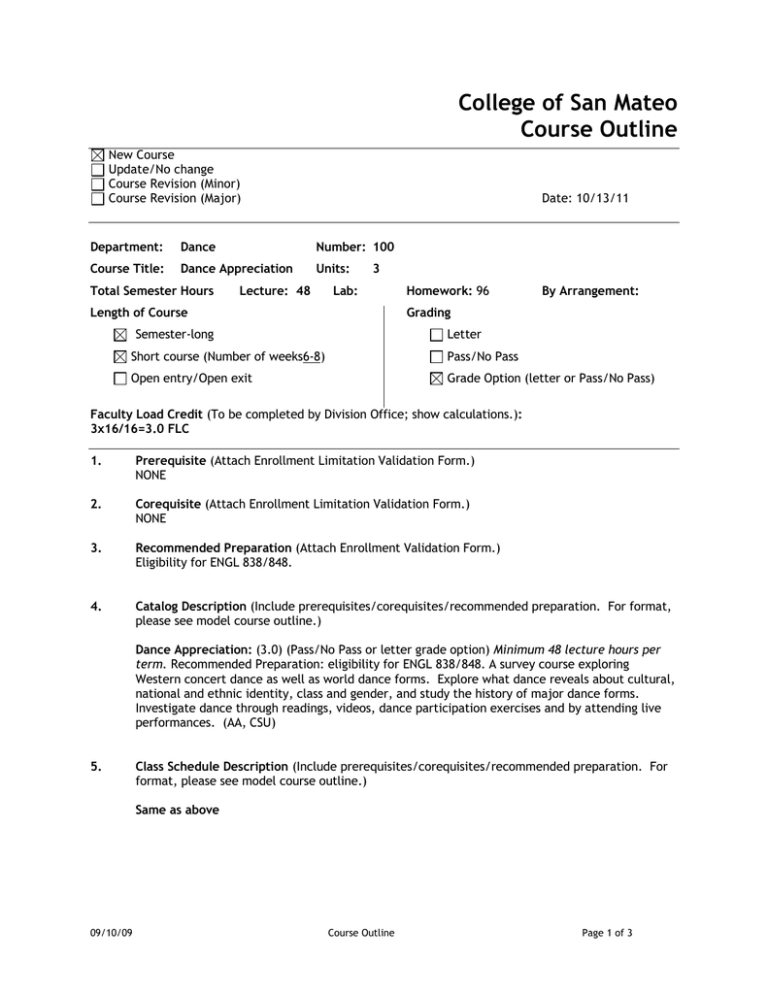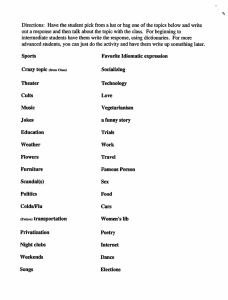College of San Mateo Course Outline
advertisement

College of San Mateo Course Outline New Course Update/No change Course Revision (Minor) Course Revision (Major) Date: 10/13/11 Department: Dance Number: 100 Course Title: Dance Appreciation Units: Total Semester Hours Lecture: 48 3 Lab: Length of Course Homework: 96 By Arrangement: Grading Semester-long Letter Short course (Number of weeks6-8) Pass/No Pass Open entry/Open exit Grade Option (letter or Pass/No Pass) Faculty Load Credit (To be completed by Division Office; show calculations.): 3x16/16=3.0 FLC 1. Prerequisite (Attach Enrollment Limitation Validation Form.) NONE 2. Corequisite (Attach Enrollment Limitation Validation Form.) NONE 3. Recommended Preparation (Attach Enrollment Validation Form.) Eligibility for ENGL 838/848. 4. Catalog Description (Include prerequisites/corequisites/recommended preparation. For format, please see model course outline.) Dance Appreciation: (3.0) (Pass/No Pass or letter grade option) Minimum 48 lecture hours per term. Recommended Preparation: eligibility for ENGL 838/848. A survey course exploring Western concert dance as well as world dance forms. Explore what dance reveals about cultural, national and ethnic identity, class and gender, and study the history of major dance forms. Investigate dance through readings, videos, dance participation exercises and by attending live performances. (AA, CSU) 5. Class Schedule Description (Include prerequisites/corequisites/recommended preparation. For format, please see model course outline.) Same as above 09/10/09 Course Outline Page 1 of 3 6. Student Learning Outcomes (Identify 1-6 expected learner outcomes using active verbs.) Upon successful completion of the course, the student will be able to: Demonstrate ability to recognize aesthetic qualities and processes that characterize works of the human intellect and imagination Respond (in writing) to works of art both analytically and affectively (in writing or through other forms of personal and artistic expression) Write clearly and effectively about topics related to dance history, dance as an art form and dance as a multi-cultural influence. • • • 7. Course Objectives (Identify specific teaching objectives detailing course content and activities. For some courses, the course objectives will be the same as the student learning outcomes. In this case, “Same as Student Learning Outcomes” is appropriate here.) Same as Student Learning Outcomes 8. Course Content (Brief but complete topical outline of the course that includes major subject areas [1-2 pages]. Should reflect all course objectives listed above. In addition, a sample course syllabus with timeline may be attached.) This course will be divided into three broad areas: Dancing for Religious/Spiritual purposes (example: origins of Bharata Natyam in India) Dancing for Social/Community reasons (examples: Social/Ballroom Dance, European Folk Dancing) Dancing for Entertainment/Performance (examples: Ballet, Modern, Musical Theatre-dance) Attend two live performances in any of these areas More specifically we will study: 1. Basic history of dance as an art form a. Pre-historic dance b. Ancient c. Medieval d. Renaissance e. Baroque f. Contemporary eras 2. Various roles involved a. Choreographer b. Dancer c. Audience 3. Specific dance styles a. Ballet b. Modern and Improvisational Dance c. Jazz d. Musical Theatredance e. Tap f. World Dance g. Social Dance 4. Dance practice/experience a. Historical Dance b. Modern and Improvisational Dance c. Social Dance 3/24/08 Course Outline Page 2 of 3 5. Viewing Dance a. Dance class/Dance rehearsal b. Assigned videotapes c. Dance concerts 9. Representative Instructional Methods (Describe instructor-initiated teaching strategies that will assist students in meeting course objectives. Describe out-of-class assignments, required reading and writing assignments, and methods for teaching critical thinking skills. If hours by arrangement are required, please indicate the additional instructional activity which will be provided during these hours, where the activity will take place, and how the activity will be supervised.) Visual: watching dance videos with instructor commentary Participatory discussions: following each video example Reading: weekly textbook assignments Lecture: note-taking and preparation for exams Writing: formal academic paper Informal Dance/Video journal: these are not class notes; students must process what they have learned at a deeper level than merely describing what they have seen. Kinesthetic/dance experience: going into the dance studio 3-4 times per semester Observe live dance events: attend 2 dance performances/events Library: learn to use the campus library by completing outside reading assignment 10. Representative Methods of Evaluation (Describe measurement of student progress toward course objectives. Courses with required writing component and/or problem-solving emphasis must reflect critical thinking component. If skills class, then applied skills.) Participation: keeping track of participation on dance studio days, and contributions to class discussions Informal Writing: grading the weekly journal, assessing critical thinking by their comments on the videos, class discussions, movement experiences and live performances Formal Writing: grading final paper reviewing a dance performance, or researching a specific dance style; graded on grammar, punctuation, and spelling as well as content and cohesiveness. Two dance class observations: assess the experience in weekly journal Library: assess their report on the assigned library readings Mid-term and Final exams: containing both objective and subjective test questions 11. Representative Text Materials (With few exceptions, texts need to be current. Include publication dates.) LEARNING ABOUT DANCE, 6TH Edition, by Nora Ambrosio; Kendall-Hunt, August, 2010 Prepared by: Email address: Submission Date: 3/24/08 (Signature) jcwalton@gmail.com OR waltonj@smccd.edu 9/7/2011 Course Outline Page 3 of 3



